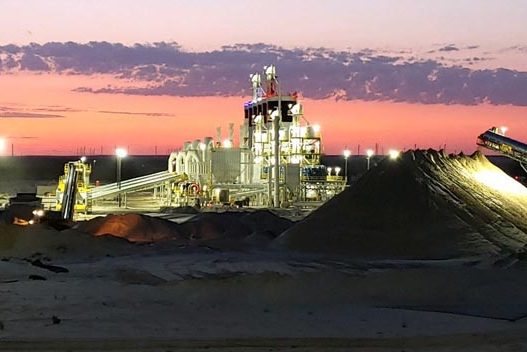Guest Contributor Introduction From Joseph Triepke:
If you’ve been around the pressure pumping business for a while, there’s a good chance you know today’s guest contributor: Dave Frattaroli. Dave is one of those guys that’s truly “been there, done that.”
He worked for 30 years at Unimin and Sibelco, selling sand and other industrial minerals to just about every buyer in the marketplace. Today, he is Executive Vice President of Business Development at High Roller Sand, as well as holding Board positions at Northern Silica in Golden, BC and Hudson Resources in Greenland.
Having gotten to know Dave pretty well over the past several years, I highly respect his sand market knowledge and his dedication to the industry, his clients, and the firm he represents. When Dave says he’s going to do something, he does it.
Dave is willing to answer the tough questions. He thinks deeply and speaks his mind. So rather than our typical “essay” submission, Dave and I came at his guest contribution in a slightly different format today.
The Q&A “transcript” below documents a recent conversation Dave and I had by phone about sand market trends. There’s no shortage of hot takes here! More importantly, Dave addresses the future of frac sand and the industry’s current struggle for sustainability in a thought-provoking way. And if you would like to hear more from Dave and others on the front-lines of the quest for frac sand sustainability, he’ll be on the opening panel with me at the Petroleum Connection’s Frac Sand Industry Update event in Houston about a month from now (check out the preliminary agenda and register here).
Hot Takes On Frac Sand’s Sustainability Struggle From A 30+ Year Veteran
 Dave Frattaroli
Dave Frattaroli
December 20, 2019
Infill Thinking: The frac sand business seems to have lost its way… how are you dealing with the fall-out sweeping the industry since you lead business development efforts for a large Permian local sand operation?
Dave Frattaroli: “Having been through this so many times, I have a simple plan for how to deal with it. Just lay low. I’m not talking about being lazy but be very conscious of your customer’s predicament in everything you do. Be very efficient and careful in your preparation for every call and discussion. If you don’t have anything nice or important to say, don’t say anything at all. An old-school European sand salesman told me once during another downcycle in the glass industry in the past: ‘in times like this, don’t make the unnecessary sales call… if you do, they’ll be forced to ask for a concession that you don’t want to give and they don’t want to ask for.’ That was from a guy who’d seen it all from way back when.
So, it makes sense not to push it right now. Some desperate people have lost sight of the value of a relationship. They’ve lost sight of the value of sand and its critical role in low cost US shale development. You have to pay attention to what your customer wants in times like these, rather than pushing hard to make the sale. Talk to them, visit them in person, keep the relationship strong, ask how you can help, but don’t try and force a deal.”
Infill Thinking: In all sorts of markets, not just sand, price paid can disconnect from value. I suspect that’s what happening in sand today since sand is an essential ingredient in the frac recipe yet being sold at no or even negative margins in some cases. What do you think is the fair value of frac sand going forward?
Dave Frattaroli: “Surprise, it’s not a number, this despite the desire of everyone to see a number in today’s world of public frac sand companies. Oil and gas production through horizontal drilling and hydraulic fracturing is impossible without sand. So the value should be a measure of sand’s contribution to low cost shale development. That must be determined by the E&P, pressure pumper, logistics provider and sand producer in concert. The innovative removal of rail/transloading freight costs by in-basin Permian sand has driven the majority of realized well cost reductions in the Permian. However, the oversupply of sand has played right into the hands of some inefficient customers who demand even more cost savings to stay alive. Some of the most sophisticated pressure pumpers and operators in today’s sand market understand the need to put value on supplier service quality. These buyers demand a very high level of service, continuity and uptime accompanying the proppant they buy and pump. So you’d better be ready when you work for them. Right now, pricing isn’t fair – it’s been driven down unsustainably. And sand has more value than price suggests because without it you can’t produce oil & gas.”
Infill Thinking: How will the frac sand niche find its footing and how can we make the supply stack a sustainable business again?
Dave Frattaroli: “Even the richest of fools who are prepared to lose money for a while can’t sell below cost and make a viable business of it. You’ll end up with tired people, quality will cave, and what about safety? Even the lowest cost producers simply can’t maintain high quality operations and products when prices trend below cost. Producers will start to ask people to work more for less, and sooner or later, it’s a recipe for disaster. Service, product and training quality will all begin to suffer. Capacity is and will continue to go away until the market balances. E&P, pressure pumper and sand suppliers need to work together to arrive at sustainable market conditions because with the current completion technology, you cannot make oil and gas without sand.”
Infill Thinking: Do you think customers understand the risk of sand supplier operations becoming unstable in these business conditions?
Dave Frattaroli: “E&Ps at $60 oil have gotten such a bang out of cheap sand, but it’s never enough. Some just keep pushing. There are some inexperienced E&P procurement guys that are continually putting out RFPs to get lower price points and just beat up whoever they are benchmarking against. These are not career procurement folks, and certainly not operations folks mind you. Career oilfield operations folks understand the value of quality sand showing up on time and in spec and are more willing to talk about value. But some of the behavior we see in the RFP process right now is downright unethical. It has to stop as it is provoking desperation on the part of suppliers that is not sustainable.”
Infill Thinking: ESG has been a big buzzword and E&P operators are talking a lot about it. Can the upstream industry have a strong ESG score AND sand pricing at or below cost at the same time? It doesn’t seem possible to have both?
Dave Frattaroli: “It is impossible. If customers want sustainable practices from suppliers, they must pay for it. For sand miners to be good citizens and environmental stewards, we must mine responsibly and be fair to the land and local communities where we work. We are going to dig a big hole, make noise, and run lots of heavy equipment. Treating the land right before, during, and after that process has a cost. We must set aside reserves. That has a cost. We must pay for and support academic and regulatory environmental studies. That has a cost. We must set aside money to reclaim the land. That has a cost too. We can’t compromise on these things as an industry, yet all this will go out the window for some suppliers when they are fighting for their next breath. They are being forced by customers to decide between paying their people or taking care of the environment? What do you think they are going to do? I will tell you this though… the good industrial mineral mining companies that have been around forever have always been about ESG – it’s just a new acronym for the industry now.”
Infill Thinking: In some ways do you think this market situation is the frac sand industry’s own fault for overbuilding and pricing aggressively when leverage was on its side?
Dave Frattaroli: “Of course. Two or three years ago, everyone was looking at the same data on demand growth and the supply shortfall. The signal told everyone the same thing: ‘grow, grow, grow’ and customers were screaming at us saying ‘more, more, more.’ At High Roller, we had true partners, not customers, saying ‘if you build it, we’ll be there buying from you.’ If you have a customer saying, ‘build it, I’ll buy it,’ that’s something I’ll do 9 times out of 10. But all of us sand producers were all looking at our own mines and not at the scale of the industry in sum. If sand gets tight again next year, you may see people add supply and or look for revenge because customers will again be desperate for sand. At the end of the day though, I believe that relationships matter. It’s easy to be friends when the sun is shining, it’s difficult to be friends now. The good companies find a way.
Some of our Permian competitors famously beat their chest for selling at $100/ton a year ago. 100 mesh sand has never been worth that much. Now it’s come back to bite them. Customers haven’t forgotten that and some of the most aggressive mines on price when the market was tight are now fighting for their lives. You just can’t do that and expect to live through the bad times. We’ve gotta find some sort of equilibrium. What is sand really worth? At High Roller we never contracted above $50/ton, even when folks were screaming for it. That long-term vision of relationship and value is what’s going to get us through on the other side.”
Infill Thinking: Are take-or-pay sand contracts worth anything anymore? They’ve been busted up in multiple cycles now…
Dave Frattaroli: “First a little background… at my old firm, we invented the take-or-pay contract. We didn’t have any speculation money at the time, this was in the 1980s. We were lean, innovative and tying to grow. We spent our money where we thought we’d get a return, but in industrial sand it’s sometimes 18-24 months from the time you say ‘go’ on a mine buildout until you sell sand. So we started with the big service companies and told them if they agreed to buy what we made, we’d build capacity.
It’s no longer a good tool. It doesn’t work for our ever-changing business model because present contract terms don’t reflect the future market – on volume or price. There’s always a mismatch. Take-or-pay deals are constantly being renegotiated. So, what’s a contract worth? It’s a piece of paper that gets you and your customer to the table. It’s not about liquidating the damages implied by the piece of paper. That contract is not worth the paper it’s written on if you are not willing to go up and down with the fundamentals, and the customer gets more than 50% of the benefit up or down. It simply gets you and your customer to the table. In the end are you really going to sue? You might not have any choice. Bankruptcy or sue? You sue. But for the most part, take-or-pay should be a platform for you and your customer to discuss how to work together.”
Infill Thinking: Are you seeing any innovation in bleeding edge contract structures that might make them executable again?
Dave Frattaroli: “You sometimes hear about percent of wallet. If you are dealing with a customer that has fixed long-term positions or contiguous acreage and will agree to buy a certain amount of the sand that they need from you… that is something they can commit to. If they agree to do half of however many wells they frac with you and half with another vendor, that’s executable and auditable. The volume and revenue you can’t take to the bank, but it’s better than forcing a customer to buy something that they cannot use. That’s un-American.”
Infill Thinking: Does API spec still matter?
Dave Frattaroli: “API RP 19-c is still valid as it’s more than just K-value. % in-size, Turbidity, % fines (dust) – Roundness and Sphericity, acid solubility all play important factors in specific completion performance. I believe the term is often misused to only refer to crush resistance. In fact, there is no specification in API for k-value. Customers don’t want dust or cloudy water when they are mixing their chemical. So, API spec is still relevant, it’s just been misused a bit and certainly is misinterpreted.”
Infill Thinking: Will NWS have any value outside of the Appalachian and Bakken in the Lower 48 in the long-run?
Dave Frattaroli: “I believe that it will. If you print one thing from me, print this: the term ‘Northern White Sand’ is a marketing tool, nothing more. There are sands branded as NWS that aren’t from the north and aren’t white. Similarly, not all local in-basin sand is brown. But back to the question, not all in-basin sands are created equal. In the Permian, local sand is the perfect storm of proximity and fitness for use. The Permian dune resource is unique. As completion technology changed to 40/70 and 100 mesh slick water, the Permian Dune sand has that unique combination of grain size, grain shape, proximity to the Midland and Delaware basin and fitness for use that seems too good to be true. But it has been proven to be the driving force in Permian production increases and sustainable cost reductions in a low oil &gas price environment.
Deposits like those in West Texas might not exist in the Eagle Ford, the DJ Basin, the Powder River Basin, etc. The only reason we weren’t using Permian dune sand since the beginning of time was because 20/40 was always King, and the Permian dunes do not contain any 20/40, hence they were evaluated and rejected on that basis. All of the geology and exploration was based on how much 20/40 you could get and use that to determine life of reserves. Then… enter slickwater fracs and 40/70/100 mesh completions. The industry had to change the view of reality and what sand works.
Now we must think about where deposits of usable 100 mesh and 40/70 are. That’s what happened in the Permian. I believe there will still be a market for high quality sand marketed as ‘NWS’, but it’s going to end up being on a case-by-case basis that will require cooperation from the railroads. And let me tell you… to even use the words ‘cooperation’ and ‘railroad’ in same sentence is a stretch. The Marcellus is an easy target for NWS because of barge from Missouri and the straight shot on rail from Illinois. But even then, the advent of Permian local sand has permanently changed the transparency of cost of sand in every basin.”
Infill Thinking: How does the Permian sand oversupply problem get solved?
Dave Frattaroli: “Everyone is waiting for the other guy to blink or for some type of consolidation wave. I believe that a combination of closures and M&A is probably the answer, but it has to be M&A at a more reasonable expectation than what everyone went in with. Bid / asks still have to narrow and you have to see more willingness on the part of buyers and sellers to arrive at reasonable valuations that reflect new long-term market realities. When that happens, and we see 15 players turn into say 5, then we’ll arrive at a more sustainable industry. It will be some combination of closure and consolidation. Some plants will close forever, and the best will survive.”
Infill Thinking: What’s the right business model for the frac sand industry in the long-run?
Dave Frattaroli: “Industrial minerals mining, including for frac sand, is a long-term business as 20+ years of resources are common. This does not fit well with the current short-term quarterly view of profitability demanded by Wall Street. Perhaps re-privatization is the next wave in our business? Also, now that operators have pressure pumping, sand proppant and logistics cost transparency, re-bundling frac sand with services is likely, especially for those E&P’s not prepared to staff 24/7 supply-chain departments. The best service companies have become incredibly efficient, supply-chain machines.
Infill Thinking: Any parting thoughts you’d like to share with “listeners”?
Dave Frattaroli: “I believe that the US oil and gas business is a big part of our future energy needs and still has great opportunity. It’s why we still do this, even when it’s not ‘popular.’ The High Roller team (and others like them) are great examples of hard work, integrity, family values and personal pride all playing a part in America’s Energy Independence. Let’s not forget that big picture of long-term, mutually-beneficial relationships while negotiating price and value in this downturn.”
Published with permission from Infill Thinking

